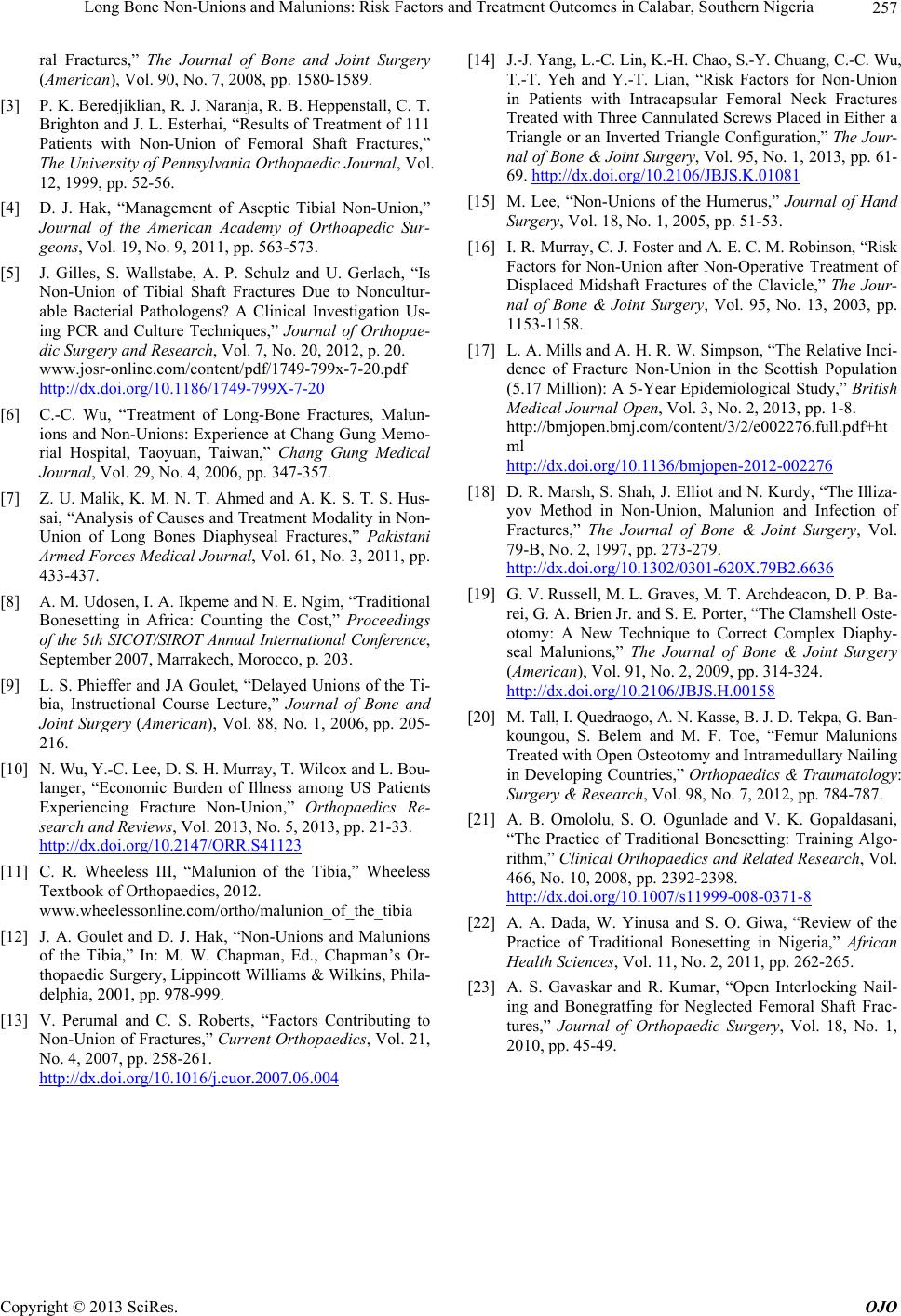
Long Bone Non-Unions and Malunions: Risk Factors and Treatment Outcomes in Calabar, Southern Nigeria
Copyright © 2013 SciRes. OJO
257
ral Fractures,” The Journal of Bone and Joint Surgery
(American), Vol. 90, No. 7, 2008, pp. 1580-1589.
[3] P. K. Beredjiklian, R. J. Naranja, R. B. Heppenstall, C. T.
Brighton and J. L. Esterhai, “Results of Treatment of 111
Patients with Non-Union of Femoral Shaft Fractures,”
The University of Pennsylvania Orthopaedic Journal, Vol.
12, 1999, pp. 52-56.
[4] D. J. Hak, “Management of Aseptic Tibial Non-Union,”
Journal of the American Academy of Orthoapedic Sur-
geons, Vol. 19, No. 9, 2011, pp. 563-573.
[5] J. Gilles, S. Wallstabe, A. P. Schulz and U. Gerlach, “Is
Non-Union of Tibial Shaft Fractures Due to Noncultur-
able Bacterial Pathologens? A Clinical Investigation Us-
ing PCR and Culture Techniques,” Journal of Orthopae-
dic Surgery and Research, Vol. 7, No. 20, 2012, p. 20.
www.josr-online.com/content/pdf/1749-799x-7-20.pdf
http://dx.doi.org/10.1186/1749-799X-7-20
[6] C.-C. Wu, “Treatment of Long-Bone Fractures, Malun-
ions and Non-Unions: Experience at Chang Gung Memo-
rial Hospital, Taoyuan, Taiwan,” Chang Gung Medical
Journal, Vol. 29, No. 4, 2006, pp. 347-357.
[7] Z. U. Malik, K. M. N. T. Ahmed and A. K. S. T. S. Hus-
sai, “Analysis of Causes and Treatment Modality in Non-
Union of Long Bones Diaphyseal Fractures,” Pakistani
Armed Forces Medical Journal, Vol. 61, No. 3, 2011, pp.
433-437.
[8] A. M. Udosen, I. A. Ikpeme and N. E. Ngim, “Traditional
Bonesetting in Africa: Counting the Cost,” Proceedings
of the 5th SICOT/SIROT Annual International Conference,
September 2007, Marrakech, Morocco, p. 203.
[9] L. S. Phieffer and JA Goulet, “Delayed Unions of the Ti-
bia, Instructional Course Lecture,” Journal of Bone and
Joint Surgery (American), Vol. 88, No. 1, 2006, pp. 205-
216.
[10] N. Wu, Y.-C. Lee, D. S. H. Murray, T. Wilcox and L. Bou-
langer, “Economic Burden of Illness among US Patients
Experiencing Fracture Non-Union,” Orthopaedics Re-
search and Reviews, Vol. 2013, No. 5, 2013, pp. 21-33.
http://dx.doi.org/10.2147/ORR.S41123
[11] C. R. Wheeless III, “Malunion of the Tibia,” Wheeless
Textbook of Orthopaedics, 2012.
www.wheelessonline.com/ortho/malunion_of_the_tibia
[12] J. A. Goulet and D. J. Hak, “Non-Unions and Malunions
of the Tibia,” In: M. W. Chapman, Ed., Chapman’s Or-
thopaedic Surgery, Lippincott Williams & Wilkins, Phila-
delphia, 2001, pp. 978-999.
[13] V. Perumal and C. S. Roberts, “Factors Contributing to
Non-Union of Fractures,” Current Orthopaedics, Vol. 21,
No. 4, 2007, pp. 258-261.
http://dx.doi.org/10.1016/j.cuor.2007.06.004
[14] J.-J. Yang, L.-C. Lin, K.-H. Chao, S.-Y. Chuang, C.-C. Wu,
T.-T. Yeh and Y.-T. Lian, “Risk Factors for Non-Union
in Patients with Intracapsular Femoral Neck Fractures
Treated with Three Cannulated Screws Placed in Either a
Triangle or an Inverted Triangle Configuration,” The Jour-
nal of Bone & Joint Surgery, Vol. 95, No. 1, 2013, pp. 61-
69. http://dx.doi.org/10.2106/JBJS.K.01081
[15] M. Lee, “Non-Unions of the Humerus,” Journal of Hand
Surgery, Vol. 18, No. 1, 2005, pp. 51-53.
[16] I. R. Murray, C. J. Foster and A. E. C. M. Robinson, “Risk
Factors for Non-Union after Non-Operative Treatment of
Displaced Midshaft Fractures of the Clavicle,” The Jour-
nal of Bone & Joint Surgery, Vol. 95, No. 13, 2003, pp.
1153-1158.
[17] L. A. Mills and A. H. R. W. Simpson, “The Relative Inci-
dence of Fracture Non-Union in the Scottish Population
(5.17 Million): A 5-Year Epidemiological Study,” British
Medical Journal Open, Vol. 3, No. 2, 2013, pp. 1-8.
http://bmjopen.bmj.com/content/3/2/e002276.full.pdf+ht
ml
http://dx.doi.org/10.1136/bmjopen-2012-002276
[18] D. R. Marsh, S. Shah, J. Elliot and N. Kurdy, “The Illiza-
yov Method in Non-Union, Malunion and Infection of
Fractures,” The Journal of Bone & Joint Surgery, Vol.
79-B, No. 2, 1997, pp. 273-279.
http://dx.doi.org/10.1302/0301-620X.79B2.6636
[19] G. V. Russell, M. L. Graves, M. T. Archdeacon, D. P. Ba-
rei, G. A. Brien Jr. and S. E. Porter, “The Clamshell Oste-
otomy: A New Technique to Correct Complex Diaphy-
seal Malunions,” The Journal of Bone & Joint Surgery
(American), Vol. 91, No. 2, 2009, pp. 314-324.
http://dx.doi.org/10.2106/JBJS.H.00158
[20] M. Tall, I. Quedraogo, A. N. Kasse, B. J. D. Tekpa, G. Ban-
koungou, S. Belem and M. F. Toe, “Femur Malunions
Treated with Open Osteotomy and Intramedullary Nailing
in Developing Countries,” Orthopaedics & Traumatology:
Surgery & Research, Vol. 98, No. 7, 2012, pp. 784-787.
[21] A. B. Omololu, S. O. Ogunlade and V. K. Gopaldasani,
“The Practice of Traditional Bonesetting: Training Algo-
rithm,” Clinical Orthopaedics and Related Research, Vol.
466, No. 10, 2008, pp. 2392-2398.
http://dx.doi.org/10.1007/s11999-008-0371-8
[22] A. A. Dada, W. Yinusa and S. O. Giwa, “Review of the
Practice of Traditional Bonesetting in Nigeria,” African
Health Sciences, Vol. 11, No. 2, 2011, pp. 262-265.
[23] A. S. Gavaskar and R. Kumar, “Open Interlocking Nail-
ing and Bonegratfing for Neglected Femoral Shaft Frac-
tures,” Journal of Orthopaedic Surgery, Vol. 18, No. 1,
2010, pp. 45-49.